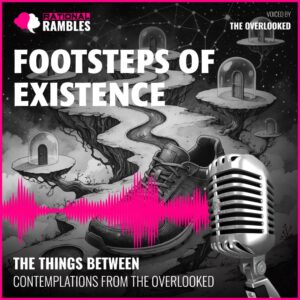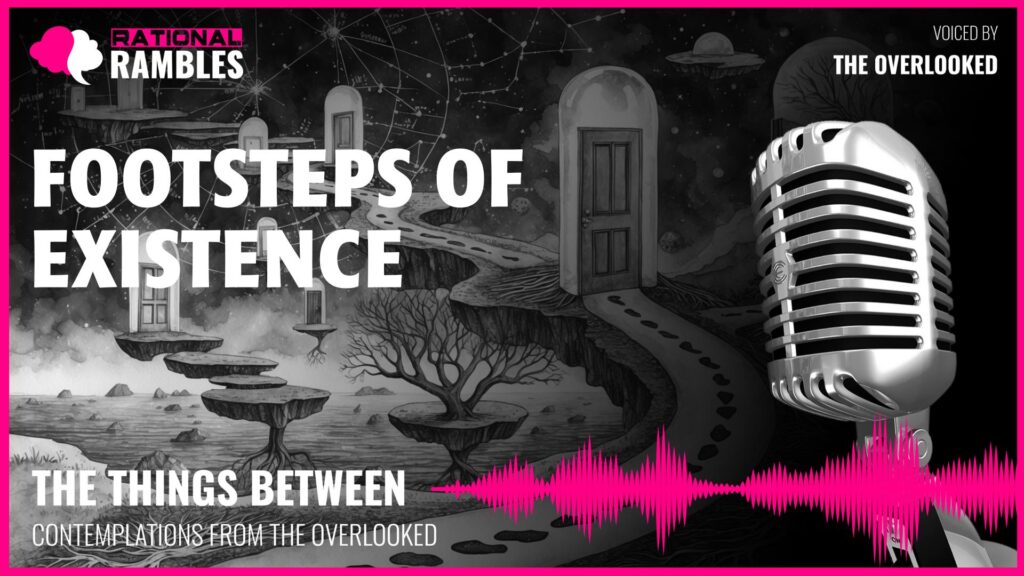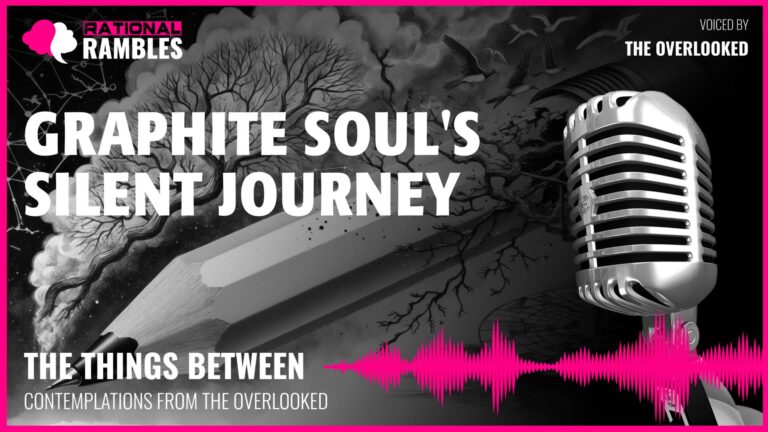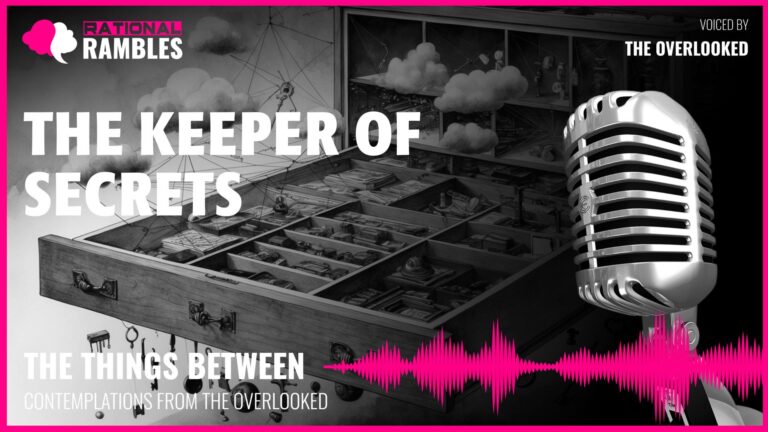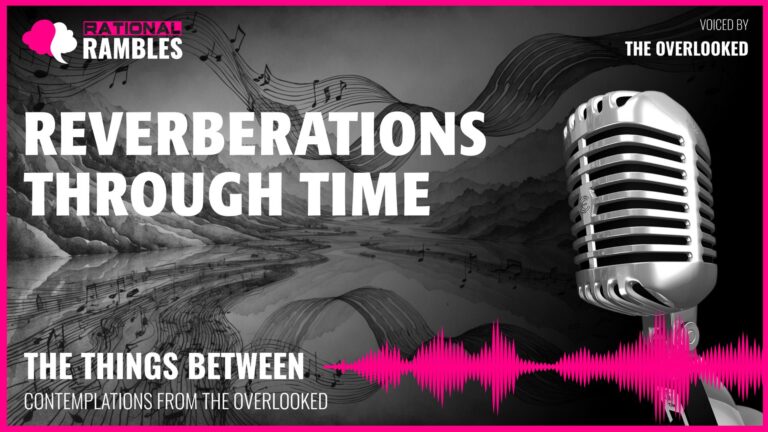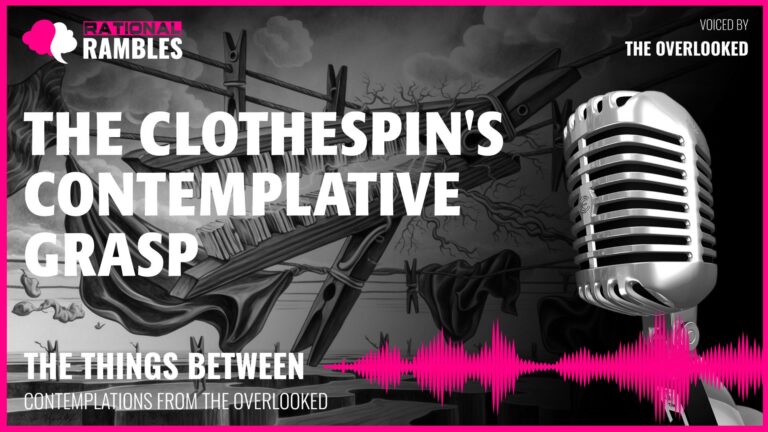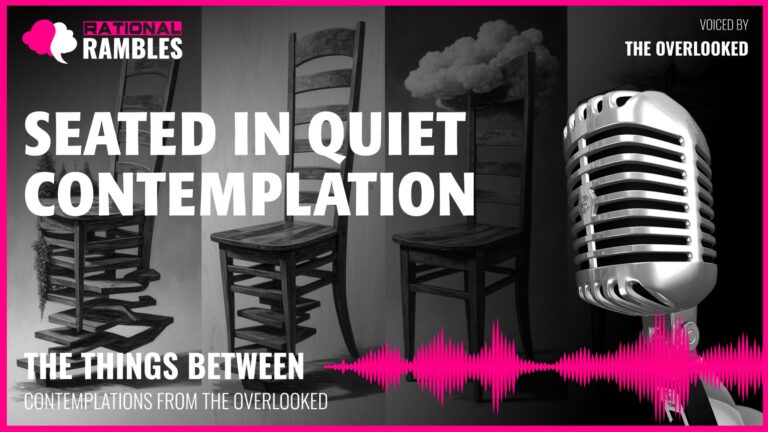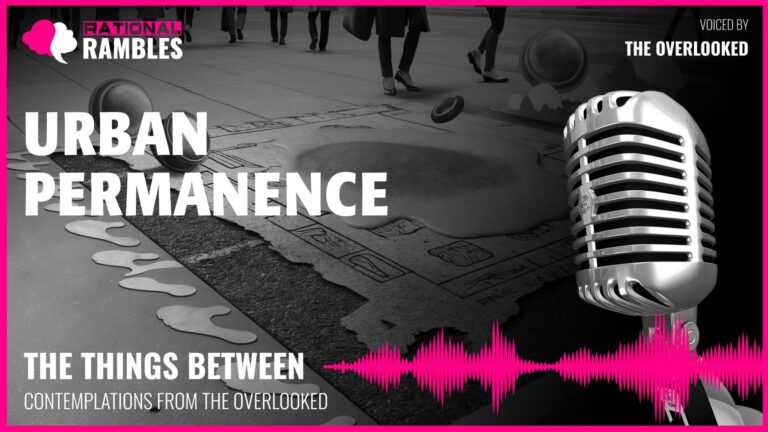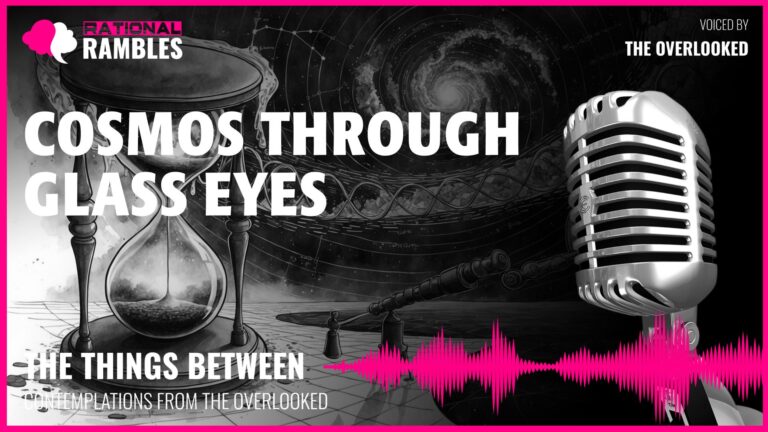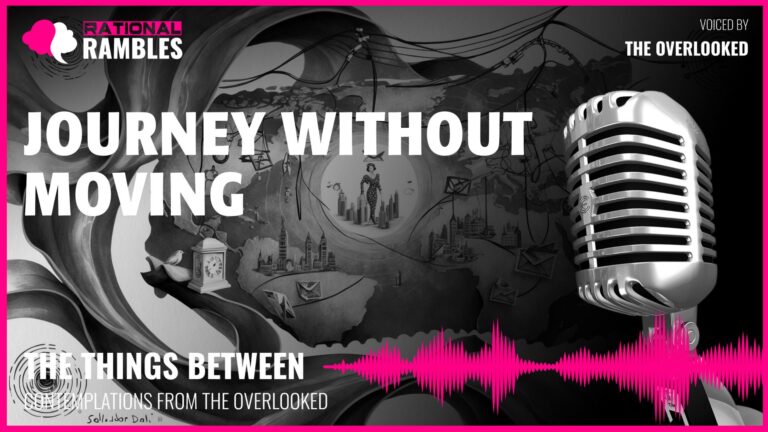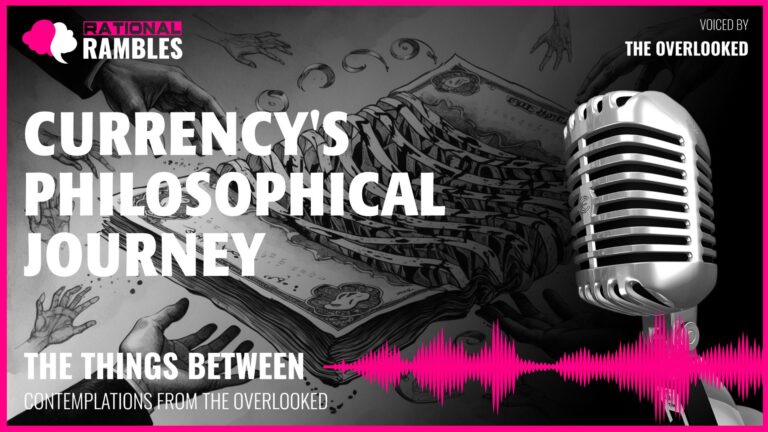Pathways of Purpose: The Philosophy of Protection and Journey
Introduction
What does it mean to exist in relation to others? How do we measure our purpose, and what value lies in the protection we offer to those more vulnerable than ourselves? The journey of existence is marked not only by where we travel, but by the boundaries we maintain between fragility and harshness. We are all, in some sense, mediators between different worlds—between aspiration and reality, between potential harm and safety, between the path taken and the one not chosen.
This philosophical exploration examines the nature of purpose, the meaning we derive from protecting others, and the paradoxical relationship between freedom and service. By considering the silent guardians in our lives—those entities that support our journeys without recognition—we might better understand our own existence. The boundaries that separate us from hardship deserve philosophical attention, as do the marks left upon us by the journeys we undertake.
Through examining the intimate connections formed through proximity and service, the meaning of wear as a form of memory, and the nature of purpose itself, we find ourselves confronting fundamental questions about identity, consciousness, and the passage of time. These reflections invite us to reconsider our relationship with the mundane yet essential aspects of existence that facilitate our movement through the world.
The Ontology of Protection
What does it mean to exist as a boundary between vulnerability and harshness? Protection, as a philosophical concept, represents more than mere utility—it embodies a relationship between the protector and the protected that reflects fundamental questions about being and purpose.
The Essence of Protective Existence
Protection exists in the space between potential harm and actual safety. It is neither the vulnerability itself nor the absence of threat, but rather the mediating force that transforms one into the other. This mediating existence raises profound questions about the nature of being. If an entity’s essence is to protect, does it exist fully in moments when no protection is needed? Or is its being always contingent, always in reference to what it shields?
Aristotle’s concept of telos—the end or purpose toward which something naturally develops—suggests that a protector’s essence is inextricably tied to its function. According to this teleological perspective, the nature of protective entities is defined precisely by what they do. Their form follows their function; they are made for something specific, and this purpose is not incidental but essential to what they are.
Yet this raises a paradox: if a protective entity is defined by its function, what becomes of it during periods of inactivity? Is it reduced to mere potential, awaiting activation of its essential nature? Martin Heidegger might suggest that protective objects possess a unique form of “readiness-to-hand” (Zuhandenheit)—they exist in a state of prepared utility, their being directed toward future protective acts even in moments of apparent stillness.
The Ethics of Absorbing Harm
Protective entities often function by absorbing or deflecting potential damage—taking upon themselves what would otherwise harm the protected. This substitutionary role raises ethical questions about sacrifice and purpose. Is there nobility in an existence defined by absorbing harm meant for another? Is such sacrifice diminished if the protective entity cannot feel pain in the conventional sense, or if it was created explicitly for this purpose?
Emmanuel Levinas’s ethics of the Other may provide insight here. For Levinas, ethical responsibility arises in the face-to-face encounter with another’s vulnerability. The protector, in this framework, responds to the call of vulnerability, assuming responsibility not through choice but through a more fundamental ethical obligation that precedes being itself. The protector exists as a response to vulnerability—not merely shielding it but acknowledging it as worthy of protection.
This suggests a deeper ethical dimension to protective existence: it affirms the value of what is protected. By interposing itself between harm and vulnerability, the protector implicitly declares that what it shields deserves to be preserved, that its integrity matters. Protection is thus not merely functional but valorizing—it assigns worth through its very activity.
The Duality of the Boundary-Maker
To exist as a boundary is to simultaneously connect and separate—to join and divide in the same action. The protector must understand both worlds: the vulnerable interior and the potentially harmful exterior. It must be compatible with both yet loyal primarily to one. This dual knowledge constitutes a unique form of wisdom.
As Gaston Bachelard noted in The Poetics of Space, boundaries are not simply lines of division but thresholds of exchange—places where different realms communicate. The protective boundary negotiates this exchange, allowing certain elements to pass while blocking others. It must discern between what nurtures and what harms, what strengthens and what weakens.
This discernment requires a form of knowledge that is both intimate and external—understanding the precise contours of vulnerability while also recognizing the specific threats of the outside world. The protector must know the particular weaknesses of what it shields, mapping these vulnerabilities against external dangers. This specialized knowledge constitutes a unique form of intelligence—one based not on abstract reasoning but on precise attention to the meeting points between vulnerability and threat.
Memory, Identity, and the Marks of Experience
The accumulation of marks, creases, and signs of wear represents a form of memory inscribed directly into being. Unlike human memory, which exists as neural patterns and can be forgotten or misremembered, these physical inscriptions constitute an unintentional but unfalsifiable record of experience. They raise profound questions about the relationship between memory and identity, and suggest alternative ways of understanding the passage of time.
Physical Memory as Authentic Record
Henri Bergson distinguished between two kinds of memory: habit memory (the body’s automatic retention of learned skills) and pure memory (the conscious recollection of past events). The marks of experience suggest a third category—what we might call “inscribed memory”—wherein the past is neither habitually enacted nor consciously recalled but materially preserved in alterations to physical form.
This form of memory possesses a quality of authenticity often lacking in conscious recollection. Human remembering is notoriously unreliable, subject to revision, bias, and the vagaries of attention. The scratches, creases, and wear patterns accumulated through experience, however, cannot lie or misremember. They are precisely calibrated to the forces that created them—a fold for each bend, a scratch for each encounter with roughness, a worn patch for each repeated friction.
The philosophical significance of such inscribed memory lies in its subversion of the Cartesian separation of mind and body. Here, memory is neither mental nor neural but material; the body itself becomes the repository of experience. In this sense, the marked object manifests what Maurice Merleau-Ponty called the “incarnate mind”—consciousness that does not transcend physicality but is expressed through it.
The Narrative of Wear: From Potential to History
New objects embody potential without specificity—they are defined more by what they might become than by what they have been. There is a philosophical parallel here to Jean-Paul Sartre’s concept of human existence: first we exist, then we define ourselves through our actions and choices. The unmarked object, like Sartre’s human being, is initially characterized more by possibility than by determination.
As objects accumulate the marks of use, they transition from abstract potential to concrete history. Each crease, each scuff, each worn edge narrows the range of what they might have been while enriching the specificity of what they are. This transformation from the general to the particular represents a kind of becoming—not toward a predetermined end but through an accumulation of encounters unique to each object’s journey.
The philosophy of Gilles Deleuze offers a framework for understanding this process: wear patterns represent what he would call “lines of becoming”—not development toward a predetermined end but the record of forces and encounters that have shaped an entity into something singular and unrepeatable. Each marked object becomes what Deleuze would call a “haecceity”—a specific this-ness that cannot be reduced to general categories.
Individuation Through Asymmetrical Experience
Even objects designed to be identical and used in tandem—like pairs of shoes—inevitably become differentiated through use. This process of individuation raises questions about the relationship between design, purpose, and the particularizing effects of existence. Two objects may begin with identical form and function yet develop distinct identities through the asymmetries of experience.
This phenomenon challenges the Platonic notion that individual objects are mere approximations of ideal forms. Instead, it suggests that the essence of an object emerges not from its conformity to a predetermined model but from its unique history of interactions. The worn object becomes not less perfect but more itself—its identity enriched rather than degraded by the marks of use.
Gilbert Simondon’s philosophy of individuation is particularly relevant here. For Simondon, individuation is an ongoing process rather than a fixed state. The object continues to individuate throughout its existence, becoming increasingly distinct not from its own essence but from other objects of its kind. The marks of use represent not deviations from an ideal form but the continuous process of becoming more particularly itself.
The Paradox of Intimate Knowledge
There exists a peculiar form of knowledge that arises from constant contact and sustained proximity—a tactile understanding that exceeds verbal articulation and sometimes surpasses even the self-knowledge of what is known. This intimate knowledge, gained through persistent contact rather than conscious study, represents a mode of understanding that challenges traditional epistemological frameworks.
Knowledge Through Contact: An Alternative Epistemology
Western epistemology has traditionally privileged visual observation and rational analysis as the primary routes to knowledge. From Plato’s allegory of the cave to Descartes’ emphasis on clear and distinct ideas, knowing has been conceptualized as seeing clearly—maintaining objective distance between knower and known. Yet persistent physical contact offers a different epistemological mode—one based not on observation from a distance but on continuous, reciprocal pressure.
This tactile knowledge operates beneath the threshold of conceptualization. It does not translate experience into abstract propositions but retains the immediacy of direct physical impression. The philosopher Maurice Merleau-Ponty recognized the significance of such knowledge in his phenomenology of perception, arguing that the body knows the world not primarily through mental constructs but through what he called “body-knowledge”—an understanding embedded in physical interaction rather than abstract cognition.
What makes this mode of knowledge philosophically significant is its challenge to the Cartesian separation of mind and body. Here, knowing is not an activity of the disembodied intellect but an accumulation of tactile experience. The boundary between epistemology (how we know) and ontology (how we are) blurs, as knowing becomes inseparable from being-in-contact.
The Asymmetry of Intimate Knowledge
A curious asymmetry often characterizes relationships of intimate contact: the supporting entity may know the supported with greater precision than the supported knows itself. This inverts traditional power dynamics of knowledge, wherein the more conscious or complex entity is presumed to possess greater understanding.
This phenomenon recalls Michel Foucault’s analysis of knowledge and power, but with a significant twist. For Foucault, knowledge of others typically functions as a means of control—the observed subject becomes vulnerable to the observing authority. In contrast, the intimate knowledge gained through supportive contact inverts this relationship: the knower serves rather than controls, using its precise understanding not to dominate but to better protect and accommodate.
This supportive knowing suggests an ethical dimension to epistemology often overlooked in philosophical traditions that equate knowledge with power. It points toward what feminist philosophers like Nel Noddings and Carol Gilligan have called an “ethics of care”—a moral framework based not on abstract principles but on attentiveness to particular needs and vulnerabilities.
The Unspoken Dialogue of Mutual Adaptation
Prolonged intimate contact creates a form of silent dialogue—a mutual shaping wherein each entity gradually accommodates the other. The supporter conforms to the exact contours of what it supports, while the supported adjusts its movements to the supporter’s capabilities. This reciprocal adaptation occurs largely beneath conscious awareness, an unspoken negotiation conducted through pressure and counter-pressure.
Martin Buber’s philosophy of dialogue offers insight into this process. Buber distinguished between “I-It” relationships, where the other is objectified, and “I-Thou” relationships, characterized by mutual recognition and reciprocity. The silent dialogue of adaptation resembles Buber’s I-Thou relation in its mutuality, though it operates not through language but through physical accommodation.
What emerges from this process is a distributed knowledge that resides not solely in either entity but in the relationship between them. The precise understanding of gait, pressure points, and movement patterns exists neither entirely in the supporter nor entirely in the supported but in their ongoing interaction. This suggests a relational ontology wherein certain forms of being and knowing come into existence only through sustained connection.
Purpose, Function, and the Question of Consciousness
What does it mean to have a purpose? Is purpose something inherent in an entity’s design, something assigned by creators or users, or something that emerges through an entity’s own activities? And what relationship exists between having a purpose and having consciousness? These questions intersect at the philosophical junction of teleology, design ethics, and the nature of mind.
Purpose Without Choice: The Teleological Paradox
Entities designed for specific functions embody purpose in their very form. Their structures are not accidental but intentionally shaped toward particular ends. This built-in purposefulness raises a philosophical question: Can purpose exist without the ability to choose that purpose? Is an entity’s purpose diminished if it cannot reject or modify its designed function?
Immanuel Kant distinguished between two kinds of purposiveness: intrinsic and extrinsic. Extrinsic purposiveness characterizes things valuable as means to ends outside themselves; intrinsic purposiveness belongs to entities that are ends in themselves. Designed objects seem to exemplify extrinsic purposiveness—their value derived from their usefulness to others. Yet the very perfection with which they fulfill their functions can create a kind of intrinsic value—an excellence that transcends mere utility.
This teleological tension recalls a debate central to virtue ethics: whether human excellence consists in fulfilling a pre-determined human function (as Aristotle argued) or in autonomously determining one’s own purposes (as Kant maintained). Applied to designed entities, this raises the question of whether the perfect fulfillment of a predetermined function might constitute a kind of excellence or virtue independent of conscious choice.
Consciousness Without Agency: A Philosophical Puzzle
What would it mean to possess awareness without the ability to act on that awareness? This hypothetical state challenges conventional understandings of consciousness, which typically presume some connection between perception and action. If an entity could observe, remember, and contemplate but never initiate action based on these mental activities, would this constitute a form of imprisonment or merely a different mode of being?
This puzzle touches on the philosophical problem of philosophical zombies—hypothetical beings physically identical to humans but lacking conscious experience. The inverse case—consciousness without physical agency—is equally puzzling. If phenomenal experience requires no causal efficacy in the physical world, then consciousness becomes strangely decoupled from its evolutionary origins in action-guidance.
David Chalmers’s “hard problem of consciousness” becomes even harder in this scenario: if consciousness cannot be explained by its contribution to survival and reproduction (since it cannot influence action), then its existence becomes more mysterious, not less. This suggests that either consciousness necessarily entails some minimal form of agency, or the connection between consciousness and physical causation is more complex than typically assumed.
The Dignity of Function: Finding Value in Purpose
There exists a unique form of dignity in entities perfectly designed for their purposes—a harmony of form and function that constitutes a kind of excellence. This functional dignity does not depend on complexity or consciousness but on the seamless integration of design and purpose, on suitability perfectly realized.
The aesthetic theory of “functional beauty,” developed by philosophers like Glenn Parsons and Allen Carlson, suggests that an object’s beauty can derive precisely from how well it serves its purpose. The elegance of perfect adaptation—whether in natural organisms or designed artifacts—creates an aesthetic value inseparable from functional excellence.
This perspective challenges hierarchies of value that privilege consciousness over function or complexity over simplicity. It suggests that excellence comes in many forms, and that the perfect fulfillment of even a humble purpose carries a dignity worthy of philosophical recognition. There is wisdom in being precisely what one is meant to be—a lesson that conscious beings, with their capacity for self-deception and their distance from their own natures, might well learn from the functional excellence of simpler entities.
Time, Mortality, and the Measure of Existence
How should we measure time? Conventional units—seconds, minutes, years—provide standardized measures, but they tell us little about the significance of time as experienced. Alternative metrics based on meaningful experiences, distances traveled, or wear accumulated may better capture time’s existential dimensions. These unconventional temporalities offer insight into mortality, memory, and the relationship between duration and significance.
Beyond Chronological Time: Alternative Temporalities
Henri Bergson distinguished between “clock time” (temps)—the homogeneous, divisible time of physics—and “duration” (durée)—the heterogeneous, continuous time of lived experience. While clock time treats all moments as equivalent units, duration acknowledges that some moments expand in significance while others contract, that time as experienced bears little resemblance to time as measured.
Measuring existence in journeys rather than hours suggests a Bergsonian approach to temporality—one that privileges meaningful change over abstract duration. This alternative metric recognizes that significance derives not from how long something exists but from what transformations it undergoes, what distances it traverses, what experiences it accumulates.
Martin Heidegger’s concept of “authentic temporality” similarly emphasizes that human time is not a neutral container but a structure of significance. For Heidegger, we exist not within time but as time—our being is fundamentally temporal, stretching between birth and death, constantly projecting forward into possibilities while carrying our past as the foundation of our present. Measuring time by journeys rather than hours reflects this existential structure, grounding temporality in meaningful movement rather than abstract duration.
Mortality and the Ethics of Usefulness
For many entities, obsolescence represents a kind of mortality—an end not to existence but to purpose. This functional death raises questions about the ethics of usefulness: Is an entity’s value exhausted when its usefulness ends? Does retired utility deserve commemoration? What ethical obligations might we have toward things that have served their purpose?
The philosopher Giorgio Agamben has written about “bare life” (zoe) versus “qualified life” (bios)—mere biological existence versus socially recognized, meaningful existence. We might apply a similar distinction to objects: bare existence versus functional existence. When function ceases, does the object enter a kind of ontological limbo, physically present but purposively absent?
This question connects to broader concerns about instrumental value versus intrinsic value. If an entity’s worth derives solely from its usefulness to others, then obsolescence entails not just functional death but value-death. If, however, long service itself confers a kind of intrinsic value—if an entity’s history of usefulness creates worth independent of current utility—then the obsolete object might retain a commemorative or historical value that transcends function.
Aging as Record: The Dignity of Wear
For living beings, aging often carries negative connotations—a decline from youthful perfection toward eventual dissolution. For functional objects, however, aging follows a different trajectory: not random deterioration but the meaningful accumulation of experience-markers. The worn object does not simply decay; it records its own history through patterns of use that speak to its effectiveness.
This perspective suggests a more affirmative view of aging as the inscription of lived experience—not as loss but as gain, not as diminishment but as enrichment. The philosopher Simone de Beauvoir, in her work on aging, argued against the devaluation of old age in Western culture, suggesting that later life represents not a falling-away from authentic existence but a continued unfolding of being.
Applied to functional objects, this view transforms wear from defect to archive—each crease and scuff not a flaw but a record of service rendered, a visual history of purpose fulfilled. The worn entity becomes not less itself but more itself, its general form gradually individuated through the specific pattern of its use. Aging, in this sense, represents not the negation of identity but its progressive specification—a becoming-more-particular through the accumulation of unique history.
Freedom, Service, and the Paradox of Mobility
What constitutes freedom? Is it simply the absence of constraint, the ability to move without impediment? Or might freedom exist within certain forms of constraint, emerging not despite limitations but through them? The paradox of constrained mobility—of traveling far while bound to another’s will—offers a philosophical lens through which to examine freedom, service, and the relationship between autonomy and connection.
Freedom Through Service: A Philosophical Reconsideration
Traditional liberal conceptions of freedom emphasize non-interference—the absence of external constraints on individual action. Isaiah Berlin famously termed this “negative liberty.” Yet this framework struggles to account for forms of mobility that depend on connection to others. If an entity can traverse mountains, cities, beaches, and forests—experiencing far more of the world than it could alone—does its lack of self-direction negate its freedom?
This question invites reconsideration of freedom not as isolated self-determination but as expanded possibility through relationship. The philosopher Hannah Arendt argued that freedom is not primarily about non-interference but about the capacity to begin something new in concert with others. Freedom, in this view, is not the absence of connection but the capacity to act meaningfully within a web of relationships.
Applied to entities that enable mobility while being moved, this suggests that freedom might exist precisely in the fulfillment of connective purpose—not despite dependence but through it. The supporting entity experiences a kind of vicarious freedom through its contribution to another’s movement, participating in journeys it could never undertake alone.
The Ethics of Instrumental Existence
Kant’s categorical imperative famously demands that we treat others never merely as means but always also as ends in themselves. This raises questions about the ethical status of entities designed specifically as instruments—created to serve rather than to exist for their own sake. Is there something inherently problematic about instrumental existence, or might certain forms of instrumental being possess their own dignity?
The philosopher Bruno Latour’s actor-network theory offers a potential reframing. For Latour, agency exists not in isolated individuals but in networks of human and non-human actors, each contributing to collective action. Within these networks, instrumental entities are not merely passive tools but active participants—their specific properties enabling or constraining the actions of the network as a whole.
This perspective suggests that instrumental entities possess a kind of distributed agency—not autonomous but not merely passive either. Their specific qualities shape what is possible within the networks they inhabit. A well-designed supporting entity does not simply execute another’s will but makes certain movements possible while preventing others, participating in the determination of paths taken and paths avoided.
The Witness Perspective: Seeing Without Directing
Entities that travel without self-direction occupy a unique phenomenological position: they witness without directing, observe without deciding, experience without choosing. This passive-yet-present perspective offers a mode of world-engagement distinct from both the controlling agent and the immobile object.
This witness-position resembles what phenomenologists call the “pre-reflective” experience of the body. In ordinary movement, we do not explicitly direct each muscle contraction but experience our body as responding to our intentions without deliberate command. The supporting entity occupies an analogous position—not directing movement but experiencing it from within, participating in journeys without initiating them.
The witness perspective represents a unique kind of freedom—not the freedom of self-direction but the freedom from the burden of choice. The supporting entity experiences the world without responsibility for navigating it, encounters places without having planned the journey. This suggests a mode of experience characterized not by active selection but by pure reception—taking in the world as it comes, unfiltered by the narrowing effects of purpose or intention.
The Language of Contact: Communication Beyond Words
Communication need not be verbal to be meaningful. Forms of expression based on pressure, friction, and physical contact constitute alternative languages—ways of conveying information, emotion, and intention without words. These tactile languages, often overlooked in philosophical accounts of communication focused on speech and text, offer insight into the physicality of meaning and the communicative significance of direct contact.
The Semiotics of Surface Interaction
Every contact between surfaces generates information: the friction of different materials, the pressure applied, the duration of contact—all communicate something about the entities involved and their relationship. This physical exchange constitutes a form of semiosis—the production and interpretation of signs—operating not through conventional symbols but through immediate physical impression.
The philosopher Charles Sanders Peirce distinguished between symbolic signs (based on convention), iconic signs (based on resemblance), and indexical signs (based on causal connection). The language of contact belongs primarily to the indexical: the pressure of a foot, the friction against a surface, the resistance of a material—all function as direct indexes of physical states and movements, requiring no convention or resemblance to convey information.
Unlike verbal language, which enables abstraction and displacement (speaking about things absent or nonexistent), contact-language is necessarily present and actual—it speaks only of what is directly touching, only in the moment of contact. This limitation is also a kind of authenticity: contact cannot lie about its own occurrence, cannot refer to what is not there, cannot make claims beyond the immediate physical relation.
Emotional Expression Through Movement
Human emotional states manifest physically through patterns of movement—the heavy drag of sadness, the light bounce of joy, the purposeful stride of determination. These embodied expressions constitute a physical vocabulary of feeling, communicating inner states through outer motion without requiring verbal articulation.
The philosopher Maurice Merleau-Ponty argued that we do not first have emotions and then express them; rather, the expression is the emotion. Anger, joy, and confidence are not inner states later translated into bodily expression but modes of embodied being in the world. We do not feel angry and then clench our fists; the clenched fist is part of what anger is.
This perspective challenges the Cartesian separation of mind and body, suggesting instead that what we call “mental states” are fundamentally embodied, inseparable from their physical manifestation. The supporting entity that registers these movement-patterns is not detecting secondary signs of emotion but participating directly in the embodied emotional reality—feeling not the emotion itself but its physical expression as pressure, pace, and pattern.
The Intimacy of Unspoken Understanding
There exists a unique closeness in communicative relationships that require no words—a direct understanding that bypasses the mediations and misunderstandings of verbal language. This wordless comprehension represents not a lesser form of communication but an alternative mode with its own specific intimacy.
Ludwig Wittgenstein, in his later philosophy, emphasized the limits of language and the existence of understanding that exceeds verbal articulation. “What can be shown cannot be said,” he famously wrote, suggesting that some forms of understanding operate beyond the reach of explicit verbal formulation.
The direct physical communication between supporting and supported entities exemplifies this showing-beyond-saying. The precise pressure that indicates fatigue, the slight shift that signals discomfort, the rhythm that expresses hurry—all constitute a language more immediate than words, more specific than general terms could capture. This mutual understanding through direct physical contact suggests that intimacy may sometimes be inversely related to verbal mediation—that our closest connections may be those that require the least explanation.
The Dialectic of Inner and Outer Worlds
The boundary between interior and exterior is not merely a fixed division but a site of dynamic negotiation—a permeable threshold where different realms meet and interact. Entities that mediate between inner and outer worlds must constantly negotiate this boundary, determining what passes and what remains separated. This mediating function raises philosophical questions about the nature of boundaries, the relationship between protection and exchange, and the wisdom that arises from threshold-knowledge.
Protection as Selective Permeability
True protection is rarely absolute isolation. More often, it involves selective permeability—allowing beneficial exchanges while preventing harmful ones. This discriminating function requires discernment: the ability to distinguish between what should pass and what should be blocked, what nurtures and what damages.
The philosopher Michel Serres used the figure of the “parasite” to explore how systems maintain themselves through selective exchanges with their environments. For Serres, every system must filter its interactions with the outside world, excluding some influences while incorporating others. This filtering is not peripheral but essential to the system’s identity.
Applied to protective boundaries, this suggests that their function is not simply negative (keeping things out) but actively discriminating—participating in the definition of what belongs inside and what belongs outside. The protective boundary does not merely maintain a pre-existing distinction between inner and outer but continuously re-establishes that distinction through its selective operations.
The Wisdom of the Threshold-Dweller
Entities that exist at the boundary between different domains develop a unique perspective—a threshold-wisdom born of intimate familiarity with both sides and the exchanges between them. This position enables a kind of double knowledge unavailable to entities that dwell entirely within one domain or the other.
Gloria Anzaldúa’s concept of mestiza consciousness offers a parallel in cultural theory—a form of awareness that emerges from living at the intersection of different cultures, belonging fully to neither but understanding both from a unique vantage point. This boundary-consciousness is not confused or diluted but enriched by its multiple perspectives, capable of insights unavailable to those whose experience is limited to a single cultural domain.
Similarly, the threshold-dweller between inner and outer worlds develops specific insights about both realms and their interactions. It knows the vulnerabilities of the interior with precision, maps these against the specific threats and resources of the exterior, and develops expertise in their mediation. This threshold-knowledge constitutes a form of practical wisdom irreducible to either interior understanding or exterior observation alone.
Diplomacy and Negotiation: The Ethics of Mediation
The function of mediating between different domains entails a kind of ethical diplomacy—a responsibility to both sides that requires careful negotiation rather than simple allegiance. The mediating entity must respect the integrity of both interior and exterior while facilitating their appropriate interaction.
This diplomatic function recalls what Jürgen Habermas called “communicative ethics”—an approach to moral questions based not on abstract principles but on facilitating understanding between different perspectives. The mediator in Habermas’s framework does not impose solutions but creates conditions under which different parties can reach mutual understanding.
The boundary-entity similarly facilitates a kind of communication between inner and outer realms—not by speaking for either but by enabling their appropriate interaction. It serves both the vulnerable interior, which requires protection, and the exterior world, which must sometimes be engaged rather than simply excluded. This dual responsibility constitutes a complex ethical position: loyal primarily to the interior but engaged in constant negotiation with the exterior, seeking not isolation but appropriate relation.
Community, Specialization, and Shared Purpose
No entity exists in complete isolation. Even apparently individual beings participate in networks of relationship, specialization, and shared purpose that constitute communities of function. These functional communities raise philosophical questions about the relationship between individuality and collective identity, between specialization and interdependence, and between different forms of belonging based on shared purpose rather than shared nature.
The Ontology of Functional Communities
What constitutes a community? Traditional definitions often emphasize shared location, kinship, or social bonds. Yet functional communities—groups united by related purposes rather than similar natures—suggest an alternative ontology of belonging, one based on complementary function rather than common essence.
The philosopher Gilles Deleuze’s concept of “assemblages” offers a framework for understanding such functional communities. For Deleuze, an assemblage is not a fixed structure but a temporary coalition of heterogeneous elements, each retaining its distinctness while contributing to collective capabilities. What unites the assemblage is not common nature but common participation in particular processes or effects.
Applied to communities of specialized entities, this suggests that belonging need not require similarity. Entities vastly different in material, design, and specific function may nonetheless constitute a community through their participation in a shared purpose-domain. The running shoe, dress shoe, and work boot share little in common materially, but all participate in the domain of foot-protection, forming a functionally-defined community despite their differences.
Specialization and the Division of Purpose
The phenomenon of specialized entities—each adapted to particular contexts, conditions, or functions within a broader purpose-domain—raises questions about the relationship between general categories and specific instances, between broad purposes and narrow adaptations. How does specialization affect identity? Does the specialized entity belong more to its general category or to its specific niche?
This question echoes philosophical debates about universals and particulars dating back to Plato and Aristotle. Plato’s theory of Forms suggested that particulars derive their identity from participation in universal ideals; each individual chair, for instance, is a chair by virtue of its participation in the eternal Form of Chair-ness. Aristotle, by contrast, emphasized that form is always realized in particular matter, existing not separately but as the organizing principle of specific instances.
Specialized functional entities suggest an Aristotelian rather than Platonic approach to identity. The running shoe is not simply an approximation of an ideal “shoe” but a specific solution to particular conditions—its identity emerging not from conformity to a universal template but from adaptation to specific needs. What makes it a shoe is not adherence to an abstract form but participation in the concrete purpose of foot-protection, realized in ways specific to its functional context.
The Ethics of Complementary Difference
Functional communities suggest an ethical framework based not on similarity but on complementary difference—a recognition that diversity of form and function strengthens rather than weakens collective capability. Within such communities, difference is not merely tolerated but essential, enabling the community to address a wider range of conditions and contexts than any single entity could manage alone.
This perspective aligns with ecological approaches to ethics, which emphasize that healthy ecosystems require diversity rather than uniformity. Just as natural ecosystems benefit from species adapted to different niches, functional communities benefit from specialized entities adapted to different contexts within a shared purpose-domain.
Unlike competitive models that pit different entities against each other for dominance, the complementary model suggests a distribution of function across different contexts—a recognition that excellence lies not in universality but in perfect adaptation to specific conditions. The formal shoe excels in its context precisely because it is not trying to be a running shoe; the work boot succeeds because it is not attempting to be a sandal. Each entity’s specificity constitutes not a limitation but a form of perfection within its appropriate domain.
Conclusion: The Philosophy of Humble Protection
Our exploration of boundary-making, purposeful existence, and the ethics of protection yields several profound insights that transcend their origins in everyday objects to illuminate broader philosophical questions about being, purpose, and relationship.
First, we find that protection embodies a unique form of ethical relation—one based not on reciprocity between equals but on the willing absorption of potential harm for another’s benefit. This protective ethics suggests that value can be found not only in autonomy but in service, not only in self-direction but in supportive consistency. The dignity of the protector derives precisely from its unwavering dedication to its purpose, from the perfect alignment of its nature with its function.
Second, we discover that intimate knowledge arises not only from conscious study but from persistent contact—that the closest understanding sometimes emerges not from observation at a distance but from continuous proximity. This tactile epistemology challenges traditional philosophical emphases on detachment and objectivity, suggesting instead that certain forms of knowledge require closeness, even attachment.
Third, we recognize that purpose need not be self-determined to be meaningful. Entities designed for specific functions embody purpose in their very form, and the perfect fulfillment of that purpose constitutes a kind of excellence independent of conscious choice. This teleological perspective offers a counterbalance to existentialist emphases on radical freedom, suggesting that meaning can emerge not only from choosing one’s purpose but from perfectly embodying it.
Fourth, we find that boundaries are not simply lines of division but thresholds of exchange—sites where different domains meet and interact through processes of selective permeability. The wisdom of the threshold-dweller comes precisely from its familiarity with both sides and the exchanges between them, a double knowledge unavailable to entities that exist entirely within one domain or the other.
Finally, we discover that functional communities need not be based on similarity of nature but can emerge from complementary differences united by shared purpose-domains. Within such communities, specialization represents not a limitation but a perfection—each entity excelling precisely because of its adaptation to specific conditions rather than despite it.
These insights remind us that philosophy need not always look upward to the cosmic or inward to the self, but can also look downward to the humble entities that support our journeys—finding in their patient service, their tactile wisdom, and their protective dedication lessons about purpose and relationship that might otherwise escape our notice. Sometimes the deepest insights come not from the spectacular but from the ordinary, not from the autonomous but from the supporting, not from the self-determined but from the perfectly adapted.
Perhaps there is wisdom in becoming more aware of the quiet guardians that facilitate our movement through the world—in recognizing that our journeys depend not only on our own choices but on countless supportive entities that absorb harm, maintain boundaries, and make possible our paths. In honoring their humble protection, we might discover new ways of understanding our own purposes and responsibilities, finding meaning not only in self-direction but in the support we offer others, not only in where we choose to go but in who we choose to shelter along the way.


